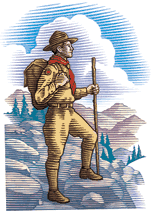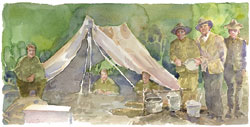![]() September 2000
September 2000

By Robert Peterson
Illustration by Richard Sparks

Few men (and even fewer boys) had ever camped out when the Boy Scouts of America was born in 1910. Most of the first Scoutmasters were men in their 20s and 30s, and they became outdoorsmen "the Scout way"—learning by doing. A handbook for Scoutmasters wouldn't be available for several years, so adult Scout leaders relied on the same manual for campcraft instruction that the boys used—the official BSA Handbook for Boys.
"We just followed the handbook," recalled the Rev. Herman A. Meyer, one of the first Scoutmasters on Staten Island, N.Y. "I had to learn about Scouting myself, and I just stayed a little ahead of the boys."
Today's camp directors would throw up their hands in horror at some of the advice in the first handbook. It suggested, for example, that the best camp shelter was a lean-to made by chopping 10 eight-foot-long branches to make the framework, over which was laid a thatch of freshly cut balsam or hemlock boughs.
Boughs were also used to make soft, fragrant "mattresses" for sleeping on the ground. The Scout laid his rubber blanket or poncho over the boughs and then an "envelope" of two woolen blankets.
Sleeping bags were available at the time, but Chief Scout Ernest Thompson Seton, the author of much of the first handbook, frowned on them. "They are too difficult to air or to adjust to different temperatures," he warned.
In the Handbook for Boys, Seton also provided directions for making several styles of tents, from either canvas duck or heavy cotton cloth waterproofed with an alum solution.
"After pitching the tent or tepee," Seton advised, "dig a trench around, with a drain on the low side to prevent flooding." Such a practice would bring shudders to today's low-impact campers.
Camp cooking utensils came from Mom's kitchen. So did most of the larder, because convenience foods like granola bars, instant rice, and pancake mixes were far in the future.
The handbook recommended menus heavy in fat and high in cholesterol. On an overnight outing, Scouts would start the day with a breakfast of fried bacon and potatoes, griddle cakes, bread with preserves, and coffee. Lunch (referred to as dinner) called for canned creamed salmon on toast, baked potatoes, pickles, bread, and some fruit. Supper included fried eggs, creamed or chipped beef, cheese, bread, and cocoa to drink.
Dishwashing was rudimentary (although not unsanitary): "First fill the frying pan with water, place over the fire, and let it boil," Scouts were advised. "Pour out water and you will find the pan has practically cleaned itself. Clean the griddle with sand and water. Greasy knives and forks may be cleaned by jabbing them into the ground. After all the grease is gotten rid of, wash in hot water and dry with cloth. Don't use the cloth first and get it greasy."
Throughout the BSA's first decade, most summer camps were run by individual troops; in some cases, two or three troops would operate a camp together.
Local councils, however, soon began to establish their own camps. (The first, Camp Owasippe, was opened by the Chicago council in southern Michigan in 1912.) Until the 1930s, Boy Scouts went to council summer camps as individuals, not with their troops. [For an account of the switch to troop camping at council camps, see the January-February 1998 The Way It Was column, "Why They Coaxed Scout Troops Into Camp."]
Several of those first Boy Scouts later recalled what camping was like.
Frederick J. Closser, who joined Troop 1 in Ontario, N.Y., a farm village near Rochester, in 1912, remembered: "Our first activity was a camping trip to Lake Ontario, four miles north of our village. We walked there, and a farm wagon carried our duffel, which consisted mostly of tarpaulins and horse blankets. A horse blanket in those days was a horse blanket—it had been used on horses and smelled like it. I think we had one or two small tents. We had a large kettle—or cauldron—like those used for butchering farm animals, and we did all our cooking in that, so we had soup or stew every day."
Store-bought backpacks were rare. Cecil F. Matson, who joined Troop 2 in Naugutuck, Conn., in 1914, told how Scouts packed for camp: "To make a pack, you laid down your ground cloth, which might be a linoleum [oilcloth] tablecloth, and put your blankets on it. Then you rolled it up in a continuous roll and bent it into a horseshoe. We'd put that horseshoe over our shoulder and tie a couple of pans or pails on our belts."
The horse and buggy age was waning and the automobile era was dawning during the BSA's infancy. R. J. Bohner remembered how Troop 1 of San Benito, Tex., got to camp in 1912: "Every time we went on a camping trip, it was a hike. We never went out in a car or truck—mostly because our parents didn't have them. They had only the horse and buggy, but we didn't use them.
"The nearest camping spot to the Methodist church where the troop met was four miles away. We would hike out carrying all our food and blankets and everything on our backs and camp out Friday and Saturday nights. We had to be back in town early enough on Sunday to get cleaned up and go to Sunday school."
Some early troops couldn't get enough of camping. Paul P. Turbey, a member of Troop 2 in Dover, Ohio, in 1916 said: "For three summers in a row we went to a place along the creek about a week after school was out for the summer, and we wouldn't go back home until a week before school started again. When we needed groceries, we sent two kids down the railroad track about four miles to Dover, and they carried the groceries back in a wash basket. Four or five adults stayed with us all summer long."
City Scouts loved camping, too. Morris Slotkin, who joined Troop 26 in Brooklyn, N.Y., in 1926, recalled: "Two or three weeks after I joined, the troop was going on an overnight hike to a park in the northern end of Manhattan. We took the elevated train into Manhattan and then for another nickel switched to the subway for the ride to the park.
"That was the beginning of my outdoor experience. I had never seen a cow; I had
never been out in the woods. The only time I ever saw a tree was in Brooklyn's Prospect
Park or when the family went on picnics to the south end of Brooklyn, which was pretty
much swamp
By the time Morris Slotkin went on his first camp-out, most local councils were operating summer camps, although not all owned the camp property. There were about 500 local council camps, but some 1,500 troops were still running their own summer camps. More than 300,000 Boy Scouts spent a week or more at summer camp each year during the mid-1920s. Camp fees varied from $5 to $7 per week.
Ah, for the good old days.
Contributing editor Robert Peterson is the author of The Boy Scouts: An American Adventure.
| The Boy Scouts of America | http://www.scouting.org |